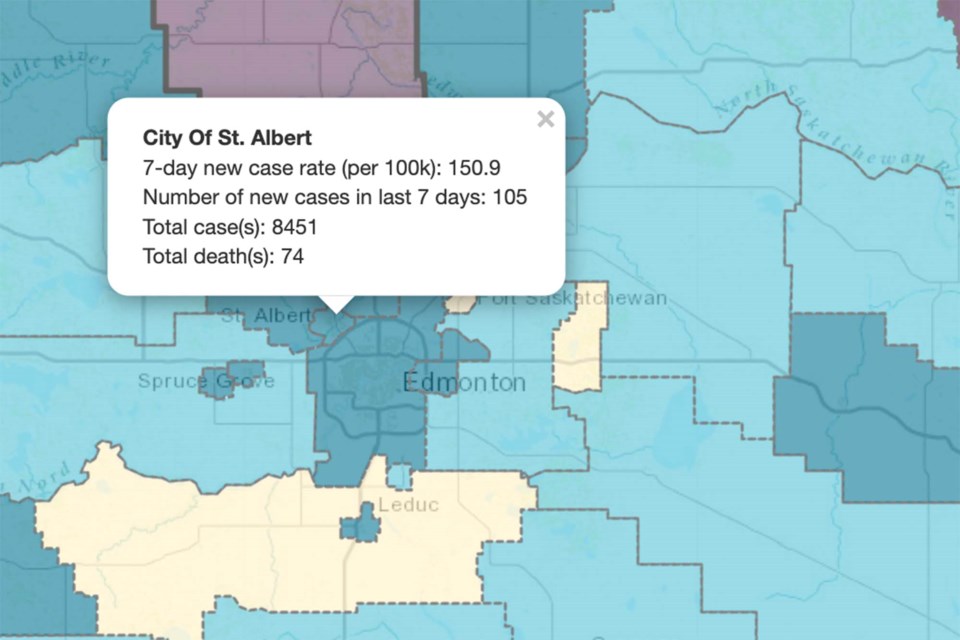COVID-19 cases in St. Albert dropped significantly over the past week, the province reported today.
The seven-day case rate per 100,000 for St. Albert was 150.9, according to data from the province gathered from April 26 to May 2, compared to the 232.8 reported April 27.
The city reached 105 new COVID cases over the seven-day period, compared to the 162 reported last week.
There have been no new COVID-related deaths in St. Albert. The total number of residents who have died of COVID remains at 74.
Sturgeon County saw a slight drop in COVID cases last week. On May 4, the province reported the seven-day case rate per 100,000 was 121.7, compared to the 154 reported on April 27.
The number of new cases in the county for the seven-day period was 34, compared to the 43 COVID cases reported on April 27.
The total number of people who have died from the virus in Sturgeon County remains at 18.
The province reported a slight decrease in Morinville COVID cases. The seven-day case rate per 100,000 for the town was 131.4, compared to the 140.2 reported last week.
Data from the province showed the number of new cases was 15, down from the 16 cases reported last week.
One more Morinville resident has died from COVID. The total number of residents who have died from COVID is 16.
During the weekly COVID update May 4, Health Minister Jason Copping said the province is seeing signs transmission is declining, but hospitals remain under stress.
“It looks like we're passing the peak of BA.2 to circulation with less impact than we saw with BA.1 one thanks to vaccine and prior exposure. But hospital admissions are still rising, and they'll continue to rise for a few more weeks, even assuming virus levels continue to decline,” he said.
Copping said Alberta is seeing an equivalent of another winter peak in patient volumes, “especially in EMS and in emergency departments. The numbers overall remain in line with past years, but occupancy at a few large sites is well over 100 per cent.”
The province reported 1,267 hospitalizations, an increase from the 1,220 reported last week. The number of people in ICU fell to 46 compared to the 47 people reported last week.
Sixty-nine people died from COVID in the province last week. The total number of Albertans who have died from COVID, to date, is 4,321.
Paxlovid access in the province has changed, the province reported.
Copping said Albertans who meet the clinical criteria for the oral treatment can now be assessed for treatment and obtain a prescription directly from a physician, nurse practitioner, or pharmacist. However, Copping said prescribers are still getting the “tools and supports they need.”
The province has also changed testing requirements. Effective immediately, the province will allow a positive rapid test result to be eligible for Paxlovid. The test can be done at home and confirmed by a prescriber or be administered by the prescriber.
A survey on long COVID is available for Albertans who want to participate.
The University of Alberta, in conjunction with Alberta Health Services, is conducting a survey on the health impacts COVID-19 has had on people in the province.
The survey can be found at https://albertapostcovidsurvey.ca/
The aim of the study, according to documents linked to the survey, is “to describe the physical and psychosocial long-term effects in people who tested positive or negative for COVID-19 in Alberta. Secondary aims include estimating the risk of longer-term symptoms and long-term patient outcomes.”
Participants are asked if they are willing to link their health records to the survey.
“This information will help us understand the link between health conditions people had before [the] COVID-19 pandemic and the long-term course of COVID-19. We will only have access to the minimum amount health information that is necessary for the study,” documents read.
The survey asks questions about a variety of the symptoms, including breathing, fatigue, and mobility issues, and asks participants to compare the symptoms to pre-COVID positivity and what they experience now. There is also a space for participants to list any symptoms they’ve had that were not included in the survey.




